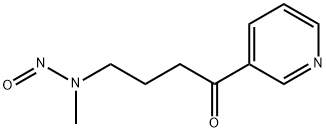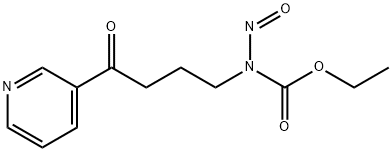4-(N-NITROSOMETHYLAMINO)-1-(3-PYRIDYL)-1-BUTANONE
Synonym(s):4-(Methylnitrosamino)-1-(3-pyridinyl)-1-butanone;4-(Methylnitrosoamino)-1-(3-pyridinyl)-1-butanone;NNK
- CAS NO.:64091-91-4
- Empirical Formula: C10H13N3O2
- Molecular Weight: 207.23
- MDL number: MFCD00274580
- SAFETY DATA SHEET (SDS)
- Update Date: 2025-01-27 09:38:02

What is 4-(N-NITROSOMETHYLAMINO)-1-(3-PYRIDYL)-1-BUTANONE?
Chemical properties
Off-White Crystals
The Uses of 4-(N-NITROSOMETHYLAMINO)-1-(3-PYRIDYL)-1-BUTANONE
This compound was present in the highest concentrations in smokeless tobacco out of the nitrosamines identified. Readily produces cancer in rats and hamsters
What are the applications of Application
4-(Methylnitrosamino)-1-(3-pyridyl)-1-butanone is a nitrosamine present in smokeless tobacco that produces cancer in rats and hamsters
Production Methods
NNK is not produced commercially. NNK is formed by oxidation and nitrosation of nicotine and is produced during the curing, aging, processing, and smoking of tobacco. NNK has been found in tobacco at levels up to 35 mg/kg, in snuff up to 8.3 mg/kg, and in cigarette smoke up to 0.5 mg per cigarette (179, 193). Common cigarette filters considerably reduce the amount of NNK that reaches the smoker. NNK is extracted from snuff by the saliva of users, and as much as 0.2 μg/g of saliva has been measured. Potential exposure to NNK is widespread also among those exposed to sidestream smoke and has been detected at 0.2–15.7 μg/ cigarette. Evidence from one comparative study of tobacco-specific nitrosamines in cigarettes suggests that levels of NNK (measured as a sum of all tobacco-specific nitrosamines) are higher in non-Moldovan cigarette tobacco and Moldovan blended cigarettes, suggesting that current tobacco production and manufacturing technologies may create conditions that favor N-nitrosation of alkaloids and other tobacco constituents.
Definition
ChEBI: 4-(N-nitrosomethylamino)-1-(3-pyridyl)butan-1-one is a nitrosamine and a member of pyridines.
General Description
Pale yellow crystalline solid.
Air & Water Reactions
4-(N-NITROSOMETHYLAMINO)-1-(3-PYRIDYL)-1-BUTANONE may be sensitive to prolonged exposure to air and light.
Reactivity Profile
A nitrated amine and ketone. Amines are chemical bases. They neutralize acids to form salts plus water. These acid-base reactions are exothermic. The amount of heat that is evolved per mole of amine in a neutralization is largely independent of the strength of the amine as a base. Amines may be incompatible with isocyanates, halogenated organics, peroxides, phenols (acidic), epoxides, anhydrides, and acid halides. Flammable gaseous hydrogen is generated by amines in combination with strong reducing agents, such as hydrides. Ketones are reactive with many acids and bases liberating heat and flammable gases (e.g., H2). The amount of heat may be sufficient to start a fire in the unreacted portion of the ketone. Ketones react with reducing agents such as hydrides, alkali metals, and nitrides to produce flammable gas (H2) and heat. Ketones are incompatible with isocyanates, aldehydes, cyanides, peroxides, and anhydrides. They react violently with aldehydes, HNO3, HNO3 + H2O2, and HClO4.
Fire Hazard
Flash point data for 4-(N-NITROSOMETHYLAMINO)-1-(3-PYRIDYL)-1-BUTANONE are not available; however, 4-(N-NITROSOMETHYLAMINO)-1-(3-PYRIDYL)-1-BUTANONE is probably combustible.
Safety Profile
Confirmed carcinogen with experimental carcinogenic and neoplastigenic data. An experimental teratogen. Mutation data reported. A flammable liquid. When heated to decomposition it emits toxic fumes of NOx.
Carcinogenicity
4-(N-Nitrosomethylamino)-1-(3-pyridyl)-1-butanone (NNK) is reasonably anticipated to be a human carcinogen based on sufficient evidence of carcinogenicity from studies in experimental animals.
Properties of 4-(N-NITROSOMETHYLAMINO)-1-(3-PYRIDYL)-1-BUTANONE
| Melting point: | 63-65°C |
| Boiling point: | 346.25°C (rough estimate) |
| Density | 1.1933 (rough estimate) |
| refractive index | 1.4830 (estimate) |
| Flash point: | 9℃ |
| storage temp. | Amber Vial, -20°C Freezer |
| solubility | DMF: 30 mg/ml, DMSO: 25 mg/ml, Ethanol: 25 mg/ml, |
| form | neat |
| pka | 3.19±0.10(Predicted) |
| form | Solid |
| color | White to light yellow |
| BRN | 3548355 |
| Stability: | Stable. Incompatible with strong oxidizing agents. |
| InChI | InChI=1S/C10H13N3O2/c1-13(12-15)7-3-5-10(14)9-4-2-6-11-8-9/h2,4,6,8H,3,5,7H2,1H3 |
| CAS DataBase Reference | 64091-91-4 |
| IARC | 1 (Vol. Sup 7, 89, 100E) 2012 |
| EPA Substance Registry System | 4-(Nitrosomethylamino)-1-(3-pyridyl)-1-butanone (64091-91-4) |
Safety information for 4-(N-NITROSOMETHYLAMINO)-1-(3-PYRIDYL)-1-BUTANONE
| Signal word | Danger |
| Pictogram(s) |
 Skull and Crossbones Acute Toxicity GHS06  Health Hazard GHS08 |
| GHS Hazard Statements |
H301:Acute toxicity,oral H317:Sensitisation, Skin H351:Carcinogenicity |
| Precautionary Statement Codes |
P201:Obtain special instructions before use. P280:Wear protective gloves/protective clothing/eye protection/face protection. P302+P352:IF ON SKIN: wash with plenty of soap and water. |
Computed Descriptors for 4-(N-NITROSOMETHYLAMINO)-1-(3-PYRIDYL)-1-BUTANONE
| InChIKey | FLAQQSHRLBFIEZ-UHFFFAOYSA-N |
| SMILES | C(C1=CC=CN=C1)(=O)CCCN(C)N=O |
New Products
1-Boc-4-cyanopiperidine tert-Butyl carbazate 1-(TERT-BUTOXYCARBONYL)-2-PYRROLIDINONE TETRABUTYLAMMONIUM CYANIDE TETRAHYDRO-2H-PYRAN-3-OL 3-Pyridineacrylic acid Nickel(II) perchlorate hexahydrate, 98% 4-Bromophenylacetonitrile, 95% 3-Bromo-4-fluoroaniline, 97% Sodium tetraborate decahydrate, 98% Palladium(II) acetate, trimer, Pd 99% 4-Bromo-2-chlorotoluene, 97% Tadalafil Clopidogrel bisulfate Sitagliptin Phosphate Monohydrate Cabergoline Fexofinadine HCl Etoricoxib 4-Amino Acetophenone 2-Chloro Acetophenone Amlodipine Base 2,3,5-Triiodobenzoic Acid Pyrrolidine Diiodo PentoxideRelated products of tetrahydrofuran
![(RS)-4-(N-METHYL-N-NITROSAMINO)-1-(3-PYRIDYL)-1-BUTANONE, [PYRIDYL-5-3H]-](https://img.chemicalbook.in/StructureFile/ChemBookStructure3/GIF/CB1345450.gif)




![4-(Acetoxymethyl)nitrosamino]-1-(3-pyridyl)-1-butanone](https://img.chemicalbook.in/CAS/GIF/127686-49-1.gif)


You may like
-
 4-(Methylnitrosamino)-1-(3-pyridyl)-1-butanone (NNK) solution CAS 64091-91-4View Details
4-(Methylnitrosamino)-1-(3-pyridyl)-1-butanone (NNK) solution CAS 64091-91-4View Details
64091-91-4 -
 4-(Methylnitrosoamino)-1-(3-pyridinyl)-1-butanone CAS 64091-91-4View Details
4-(Methylnitrosoamino)-1-(3-pyridinyl)-1-butanone CAS 64091-91-4View Details
64091-91-4 -
 366789-02-8 Riveroxaban 98%View Details
366789-02-8 Riveroxaban 98%View Details
366789-02-8 -
 Carvedilol 98%View Details
Carvedilol 98%View Details
72956-09-3 -
 Abiretorone 154229-18-2 98%View Details
Abiretorone 154229-18-2 98%View Details
154229-18-2 -
 73590-58-6 Omeprazole 98%View Details
73590-58-6 Omeprazole 98%View Details
73590-58-6 -
 201530-41-8 Deferasirox 98%View Details
201530-41-8 Deferasirox 98%View Details
201530-41-8 -
 Sertraline HCl 98%View Details
Sertraline HCl 98%View Details
79559-97-0
